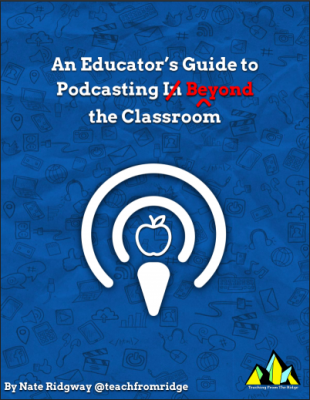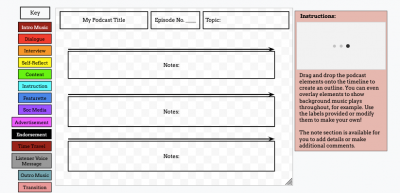
If you haven’t thought about podcasting in your classroom before, the benefits are worth it. Not sure where to start? Here is a guide to help you.
[callout]This post is written by Nate Ridgway, a tech-loving history teacher in Indianapolis, Indiana, and co-author of Don’t Ditch That Tech: Differentiation in a Digital World. You can connect with Nate on Twitter and Instagram @TeachFromRidge and check out his website teachingfromtheridge.com.[/callout]
Other than AR or VR, podcasting is one of the more recent edtech tools that has made its way into the hands of educators. And like any tool, given the right supports and practices, it can make extraordinary things possible for teachers, students, and their communities.
Maybe it’s a capstone project at the end of a unit, maybe the podcast is a learning experience, like in a PBL. However, at the end of the day, every podcast–even ones for popular use like Serial–goes through a series of steps before the mic even turns on.
If you haven’t thought about podcasting in your classroom before, the benefits are worth it.
But where do you start?
 I have put together a free eBook called An Educator’s Guide to Podcasting Beyond the Classroom that walks you through the steps to getting started. It is also packed with lots of examples and ideas for using podcasting with your students.
I have put together a free eBook called An Educator’s Guide to Podcasting Beyond the Classroom that walks you through the steps to getting started. It is also packed with lots of examples and ideas for using podcasting with your students.
Below you will find just a few excerpts from An Educator’s Guide to Podcasting Beyond the Classroom. Click this link to get your copy!
Constructing a Podcast
Step 1. Develop topics. What students eventually settle upon should be highly influenced by the particular audience they’re creating for, but there’s a whole host of ways that students can curate, filter, and refine possible subjects.
Step 2: Sketch Out the Podcast. With a topic in hand, it’s time to think about how the podcast is going to meet the learning objectives that were mentioned earlier.
For instance:
➔ Do the learning objectives demand a showing off interviewing skills? Better make sure that an interview is present in the mockup.
➔ Presented with an argument that needs evidence to disprove it? Might be a good time for a featurette or social media feedback.
➔ Does the podcast need to meet a more professional standard of production? Consider adding background music or intros.
To sketch out a podcast, try this easy-to-use template on Google Drawings.
Step 3: Master the elements. No, this isn’t a reference to earth, wind, and fire! Whatever elements from the sketch out of the podcast (like interviews, dialogue, etc) that are going to be added, need to be learned!
There’s a huge wealth of material out there on how to master the different segments that make up a podcast. Check out some of my favorite sites and resources on page 12 of the ebook!
Step 4: Make the podcast. It’s finally time to get down and start recording. With a smart device in hand-literally any kind from Ipads to Chromebooks will work–it’s time to make it happen.
Anchor is the easy way to start. Excellent for beginners and experts alike, it’s an all-in-one editing and publishing platform.
Check out these resources:
- An iorad tutorial on how to use Anchor to start a podcast.
- Why your students need a podcast: How to do it fast and free
An Alternative: Appsmashing Flipgrid & Wakelet
If you’re not sold on Anchor, FlipGrid is another way to create “ever-evolving” podcasts where comment and build upon prior “episodes”.
When the episodes are finished, teachers can curate episodes using Flipgrid mixtapes, and then organize, publish, & distribute them using Wakelet.
 If you’ve enjoyed the resources I’ve shared here and are looking for even more ways to take podcasting beyond the classroom be sure to download the free ebook. You will find even more examples and resources along with best practices and ways to include reflection and assessment in your podcasting journey.
If you’ve enjoyed the resources I’ve shared here and are looking for even more ways to take podcasting beyond the classroom be sure to download the free ebook. You will find even more examples and resources along with best practices and ways to include reflection and assessment in your podcasting journey.
Until next time, happy podcasting!
For notifications of new Ditch That Textbook content and helpful links:
Are you looking for quality, meaningful professional learning that both equips and inspires teachers?
Matt provides in-person and virtual keynotes, workshops and breakout sessions that equip, inspire and encourage teachers to create change in their classrooms. Teachers leave with loads of resources. They participate. They laugh. They see tech use and teaching in a new light. Click the link below to contact us and learn how you can bring Matt to your school or district!
Is Matt presenting near you soon? Check out his upcoming live events!




parler moi du livre l’Ethique de Spinoza le philosophe